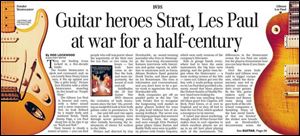
Guitar heroes Strat, Les Paul at war for a half-century
7/25/2008
They are dueling icons locked in a five-decade battle.
The Fender Stratocaster is sleek and contoured, and, as Los Lonely Boys Henry Garza says, it fits up against you like a girl s body. Picture Jimi Hendrix with a white Fender Stratocaster, muscling its fret board on Purple Haze.
The Gibson Les Paul is heavier and curvy, with a fatter sound and a more responsive feel, its look defined by a maple body and sunburst finish. Think Jimmy Page, a Les Paul slung low as he rips it up on Rock and Roll.
Their beauty is clearly a matter of tastes you can find people who will wax poetic about the superiority of the Strat over the Les Paul, or vice versa, for hours but both have come to define the look, and more importantly, the sound of rock and roll.
Solidbodies, the 50 Year Guitar War DVD dissects the evolution of both instruments since the late 50s, providing an insightful look at how both guitars came to prominence.
It s a rise-and-fall-and-rise-again story as both companies went through severe growing pains after initially becoming the instruments of choice for rockers in the 1960s.
Written and directed by Guy Hornbuckle, an award-winning journalist who lives in Mississippi, the hour-long documentary features interviews with historians and guitar experts, in addition to musicians such as Garza, Allman Brothers Band guitarist Derek Trucks, and blues guitarist Joe Bonamassa. The tone is informative and conversational, and you don t have to be a guitar wonk to appreciate the story Hornbuckle tells.
Both companies got off on parallel paths in the late 50s with Fender first to recognize the burgeoning rock market as guitar players looked for ways to play loud without lots of annoying feedback. The secret was developing pickups that removed the buzzing from the amps, and soon enough Elvis Presley s guitar player James Burton and Buddy Holly were seen in publicity photos with Fender Esquires, which were early versions of the company s Telecaster.
Kids in garage bands everywhere had to have the same instruments the big boys were playing, and the guitar wars began when the Stratocaster a more rocking version of the Tele came out. Gibson got into the fray with a multi-pickup system on its Les Paul that provided a fat, meaty sound that blues players like Hubert Sumlin of Muddy Waters band were looking for.
And who was watching those old blues guys? Eric Clapton, Jeff Beck, Peter Green, et al. over in England, and so they all had to have the Les Paul, which sparked a resurgence in its interest.
It wasn t just about marketing, though, which 50 Year Guitar War makes clear in cool vignettes in which excellent players are set up in an old beer plant playing each of the instruments. The differences in the Stratocaster versus the Les Paul are subtle, but the players demonstrate how you can hear them if you listen closely.
Over the years both Fender and Gibson were sold to bigger companies, which the documentary says led to inferior versions of their iconic guitars. By the 80s, guitar makers such as Kramer and Ibanez came along and gave both of the old-school companies a thrashing. Many of the hair metal bands of that era favored the sleeker new brands and, as Hornbuckle s documentary notes, the established companies were not making good instruments.
Both were saved by new buyers in the 80s, and the market collapsed for the usurpers when hair metal fell out of favor. Guitarists made their way back to the Strat and Les Paul as the quality improved to the original standards.
Which brings us to today. Find a guitar god and he s likely playing a Fender or Gibson. Keith Richards plays Telecasters and Strats. Bruce Springsteen, Telecasters. Pete Townshend used to play the Les Paul s little brother the SG, but now he plays Strats. Slash: Les Pauls. Jimmy Page: still playing the Les Paul.
Hornbuckle s documentary is one that any guitar aficionado is going to want to check out it s available at various online sites and at www.solidbodiesthemovie.com and it s a breezy hour well-spent for music fans who aren t aware of the intense loyalties players develop for the two guitars.
Sheryl Crow: Live
There s something about Sheryl Crow that oozes hip even though she doesn t seem to try very hard. Her music is traditional pop and Americana, not that far removed from Tom Petty in terms of delivering tasteful hooks and sing-along melodies, and her stage presence is sedate compared to the look at me antics of most of her contemporaries.
But Crow has a sexy, amiable vibe that s eminently satisfying, and when she kicks off this Soundstage production and straps on that big red bass guitar it s impossible not to be charmed, especially when she starts laying down the sinewy groove to My Favorite Mistake.
With a tight, flexible backing band, Crow works through a 17-song hit-heavy set that is typical of all the Soundstage DVD productions. The sound is perfect, and you can crank it up without losing any quality. The stage set is uncluttered and keeps the focus on the music, and the direction is clean without lots of cuts or distracting edits.
It helps that Crow and her band are all attractive people, but the emphasis remains clearly on the music and demonstrates that despite the popularity of songs like All I Wanna Do, If It Makes You Happy, and Leaving Las Vegas, Sheryl Crow is ultimately an under-appreciated musician.
This live production elevates her to the status of singer/songwriters like Petty, John Hiatt, and Lucinda Williams and that s where she belongs.
Contact Rod Lockwood at rlockwood@theblade.com or 419-724-6159.